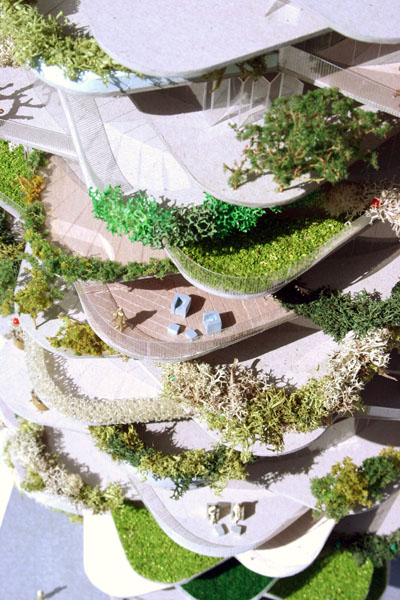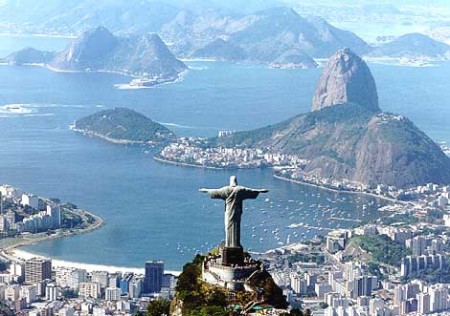
|
||
|
|
||
|
12 12
Green Rooftops Of Toronto & Other Energy Saving News
 Did you know that the Royal York Hotel has a secret, chefs only herb garden fourteen or so storeys above the din of Bay Street? I didn't until this August. One of the city's overlooked but very worthwhile organizations is the Green Tourism Association. Leanne Minichillo, the media relations co-ordinator for the GTA (is that an in joke among the city's treehugging community?) brought us to the Royal York during an afternoon tour of some of the city's eco-friendly spots -- including those on rooftops. Another is the 10,000 square foot garden found at Mountain Equipment Co-Op on King Street West. Interested in exploring Toronto's hidden eco spaces? Toronto's Green Tourism Association can take you to them. On other green friendly news, a new car sharing company -- ZipCar -- is changing the way Torontonians drive: As the largest car sharing company in the nation, we have learned through extensive research, about the significant, positive environmental impact of sharing a car. There are three major effects:
12 11
Designing The Future: Do We Have To Leave The Planet?
From an environmental policy perspective, the hope that there is a future for Homo sapiens beyond our planet is worrying. After all, why solve our problems here when we can go somewhere else? That is the history of our species and now that we’ve run out of room to expand on earth, well, let’s go somewhere else and continue the destructive process there. Now, I doubt that is what Hawking intended, but the people who influence government spending use this idea to promote research in the theoretical physics behind interstellar travel. While I’m not against advancing our knowledge of the universe, it is critical that we focus financial and intellectual resources to solve the environmental challenges we face here, today. The future may indeed include our travel to other worlds that can sustain us; however, given the urgency of our local problems the much bigger challenge is not a theoretical one. It is practical. We need to ameliorate existing environmental problems and prevent them from worsening. And that is not theory.
12 08
Prevention and Offset: Two Approaches to Turning down the Thermometer
Making amends is as natural a human inclination as any. So it’s not surprising that as climate change concerns climb up the totem pole, enterprising organisations are selling cool escape clauses (offsets) that promise to help balance off our energy intensive lifestyles by planting new trees or replacing dirty power with solar power. This is a pretty cool new green market space as long as it is treated as the second layer, where the first layer is trying to reduce as much as possible.
*For easy ways to reduce our climate footprint, Prince Charles is keen on Global Cool.
Sustainable Businesses: Steve Mann’s Hydraulophone
 Playing in the water: Even on cold Fall and Winter days, people are still drawn to play in the water to experience the soulful call of the hydraulophone, a sound sculpture and musical instrument that you play by putting your fingers on water jets. Hydraulophones used as landscape architecture give aquatic play a sophisticated and spiritually uplifting artistic element that draws people of all ages, not just children, to play in the water. By Steve Mann "Urban Beaches" ("urbeaches") are spaces that cross or challenge the traditional boundaries that have existed between professional civic life and the more playful elements of recreational life.
12 06
Climate Change Low on Teens’ Lists of Global Problems
Humans tend to worry about immediate threats. Being robbed. Getting cancer. Losing their job, and in the case of teenagers, not getting into college. Our instinct for self-preservation is strongest in the case of our own living, breathing bodies and weakest when it comes to the human race as a whole. This is a necessary fact of life in the urban jungles of some of the world’s largest cities, and perhaps more so for the teenagers that call them home. A poll conducted in October by Synovate for the BBC World Service surveyed 3050 teenagers in ten cities around the world: London, England; New York, USA; Nairobi, Kenya; Cairo, Egypt; Lagos, Nigeria; Rio de Janeiro, Brazil; Baghdad, Iraq; Delhi, India; Jakarta, Indonesia; and Moscow, Russia. On a ‘personal level’ the teenagers polled indicated that the most important issue to them at the moment was Education (38%), followed distantly by Terrorism (19%). Career (17%) and Aids (14%) rounded out the double digit percentiles, while Hunger, Obesity and Climate Change (a miniscule 3% worried about this the most) were at the back of their minds. If we run with the idea that teens are concerned mostly with themselves, its not unreasonable to consider their concerns and opinions to be a litmus test of the average adult’s visceral, instinctual reactions. Of course adults (or some of them anyway) attempt to push beyond their immediate reactions and think of someone other than themselves—their children for example, their country, or perhaps even the human race. When the teenagers were asked what which issue was most important on a global scale, their answers were slightly different. Terrorism vaulted to the top of the pack with 36% (and a whopping 63% in New York, which has had one terrorist attack in the last decade as opposed to Baghdad, which suffers one nearly once a week and where 59% cited it as the most important issue). Education retained second place with 25%, Aids stayed in third with 17%, and Climate Change was still down at the bottom with 5%. Flip back in your mind for a moment to Maslow’s Hierarchy of needs from middle school guidance class. Basic needs such as food and shelter, sleep, warmth and sex come first. Security from bodily harm, comfort and peace comes next, then social needs (belonging to a group and acceptance), then self-esteem, and at the tip top of the pyramid, intellectual stimulation and opportunities for creativity and innovation. It could be argued that climate change is the only truly global threat in the list the teenagers were given to choose from. Terrorism doesn’t touch every part of the world—though North American news might make one think it does. Aids is a health threat and therefore needs to be worried about—but at least there are ways to prevent yourself from contracting it, if your lucky enough to get your hands on one (too many are not). Education could be grouped with intellectual stimulation at the top of Maslow’s pyramid, but if one thinks about it as necessary for prosperity, and therefore health, security and safety, it makes sense. Yet there are places in the world where education is free. Climate change is going to affect every single person on earth eventually—through the weather their country receives, resource shortages, the economic changes and challenges it will bring, and the erasure of entire cities (including New York). But these threats are not immediate enough. The possibility that a teenager in any one of these cities could contract HIV is immediate. Immediate is the question of how to become educated, find a job and feed (...read more...)
New Green Architecture
 One of the requirements of sustainable architecture is density: increased housing density reduces a community’s aggregate demand for energy. Now imagine the typical North American suburban home of the last generation. They boast a single dwelling on large plots of land surrounded by metres of pesticide-soaked, fresh-mown grass. To survive, they require vast infrastructures of roads, cars, sewers, electricity generation, gasoline production, natural gas pipelines, and more. Their waste pollutes our air, streams and lakes. They gobbled up millions of acres of Canada’s prime agricultural land and disrupt our aquifers. They are not sustainable. Unfortunately, those kinds of dwellings represent the Canadian dream for many of us. Who wants to live in a condo when it is possible to have people who do make that choice help subsidize—through their taxes—our unsustainable lifestyle. After all, if suburbanites were to pay the real costs of their infrastructure needs they could not afford to live out there on the edge of our cities. Our dreams may be changing. Architects are offering suburban-like dreams in urban form. Eco-friendly condominium designs that offer external green spaces are being built and our cities may never be the same. Here is a story on one such project:

12 05
Notes from the Belly of the Liberal Leadership Convention
 By Toby Heaps By Toby HeapsThe environment won and the backroom boys lost. That's the story of this weekend's Liberal Leadership Convention. Although he wasn't on the ballot at the end, John Godfrey kicked off the green revolution in the Red party back in March, when he announced he was running for the leadership in order to put the sustainable economy at the centre of the Liberal Party. Stephane Dion quickly took the green baton from Godfrey, put it at the centre of his three-tiered new liberalism (social justice, environmental sustainability, and economic prosperity) and zestfully ran with it all the way to the finish line this weekend. Michael Ignatieff, frontrunner until the last ballot, even signed up Jamie MacDonald, a whiz kid PhD who has worked with Natural Step, to be his sustainability guru and craft his carbon tax proposal. As the campaign wore on all contenders except Joe Volpe caught the green fever (Volpe's theme song was "Life is a Highway". He joked he'd had a good ride in his red Ferrari, and then on Sunday, he showed up for a meeting with Dion, in his red SUV--which he left idling by the curb for a valet to pick up).  Even though Dion is the sustainable economy poster child and most of my idealistic Liberal friends were in his corner, some lingering doubts about his cojones remained, leftover from an interview I did with him back when he was Environment Minister. When I asked Dion what he thought about leaders in the business community (like the Shell Chairman) who said a carbon tax would be the best way to meet our Kyoto targets, he recoiled as if I'd hit him with a taser gun. He said carbon tax was a bad idea and wouldn't be considered by a Liberal government. Even though Dion is the sustainable economy poster child and most of my idealistic Liberal friends were in his corner, some lingering doubts about his cojones remained, leftover from an interview I did with him back when he was Environment Minister. When I asked Dion what he thought about leaders in the business community (like the Shell Chairman) who said a carbon tax would be the best way to meet our Kyoto targets, he recoiled as if I'd hit him with a taser gun. He said carbon tax was a bad idea and wouldn't be considered by a Liberal government.As I went into the convention centre Monday morning (I got in as media--I'd be reluctant to join any party that would accept me, and besides it's a lot cheaper that way), I was keenest on Gerard Kennedy. I knew that he had the biggest upside (his integrity and work ethic) and downside (his obstinacy), and was at least one Berlitz tape short of speaking passable French--but I understand the guy. In conversations with Liberal powerbrokers I learned he didn't return phone calls or "appreciate favours." So when it came time for lunch on Friday, I headed off to the Kennedy suite at the Hyatt for an Indian Buffet. In the elevator on the way up, several attractive Kennedy supporters were discussing their tightly fitting gK t-shirts. But they reached a consensus that the Brison camp had the nicer garb: even tighter shirts sported by cute boys. When I got to the suite I noted two bad omens: One, the food was nowhere to be seen and two, there were some pretty sketchy liberals in the room--the kind you see at nomination meetings rigging outcomes or good-naturedly relishing character assassinations. Usually the sketchy ones are the ambitious ones, so I expected they would be in the Ignatieff camp. Maybe Iggy had a screening process. It was just as well--Indian food always makes me want to take a nap--and as I made my way to the food court for some soup, I decided Kennedy might have a bigger downside than I thought. He didn't seem to have a clear plan beyond party renewal, and I shuddered to think what would happen if he had the Prime Minister's portfolio in his lap without a well-prepared plan of action. Either there would be gridlock, or he would have to rely on his coterie of (...read more...) |

Contribute to the MESH Cities intelligent city database. Click here.
Read what people are saying about the environmental issues that impact us all
News about wind energy
News about green investing
Blog posts about electric cars
|
The best green news sources on the Net
Treehugger
Eco Worrier
Inhabitat
Lime
World Changing
|


